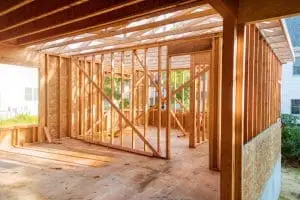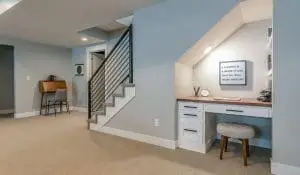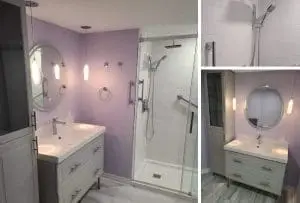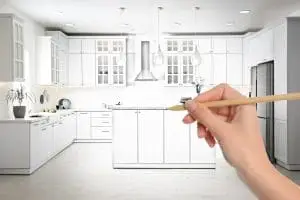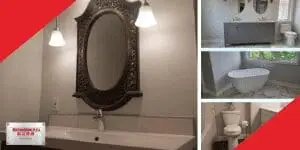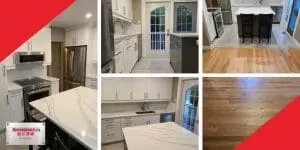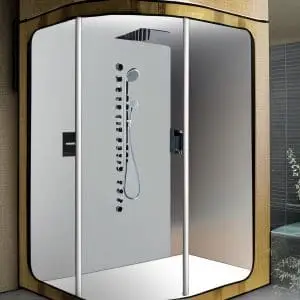Planning home renovations can be both exciting and scary to a homeowner. Some home improvements come from necessity, such as replacing a roof or upgrading your plumbing. Other home improvements increase the functionality and comfort of your home. One of the most overwhelming aspects of home renovations for many people is how they will pay for their desired home improvements. It can be especially overwhelming if the improvement is coming from necessity and is not a planned
renovation. In this article, we will outline several different options you have to finance your plans and look at the pros and cons of each choice.
Save Money
Perhaps the most obvious and straightforward way to pay for home renovations is to save up the money. Saving money is also one of the hardest ways to pay for home renovations and improvements. The advantage of using money that you have saved up is that you will not incur any additional debt during the home renovation process. Using liquid assets, such as cash, also means that you will not have to go through lengthy application processes. You will also be able to avoid paying high-interest rates and lending fees.
However, since most people do not have a surplus of money in their bank accounts, this option will require some planning.
Some of the options you must save the money you need include:
– Cutting back on discretionary purchases
– Saving all extra money
– Taking on additional jobs or working additional hours
– Selling things in your home that you no longer use
The major downfall of saving the money you need for your home renovations is that it will likely delay your projects for several months. And when other emergencies come up, you can find yourself delaying your home renovations even longer. This option could also mean that any quotes you have received from your general contractor can change. Saving money is also not a feasible option if you find yourself needing a repair done immediately.
Credit Cards
Another option to save the needed money is to use a credit card that you already have, that has a high enough credit limit. If there is not enough money on it, you can apply for a credit increase. If you choose to use this option, ensure that you are not carrying the balance for too long, as credit card interest is generally high and can add up quickly.
Personal Loans
Depending on the home remodeling project you are taking on, and how urgent the renovation is, saving money may not be the best choice. Another option is to take out a
personal loan. Depending on how much money you need to borrow and what kind of interest rate you can get, a personal loan is an excellent way to borrow money without putting your home up as collateral. Interest rates can vary from 2.49% up to 36%. If you cannot get a loan at a low-interest rate, this can be a very costly option.
Personal loans are a good back up if you are unable to obtain financing through any other means and putting off the home renovation will cost you more money in the long run. For example, if your roof is leaking, it is better to have it repaired and pay more in interest then to let it cause further damage since the additional damage will cost you more money over time. However, if you just want to change the carpets in the bedroom, that 20% interest rate probably will not be worth it, and you are better off using a credit card or saving the money.
A personal loan can be obtained through many different places, from banks to private lenders. If you choose to go with a private lender instead of a bank, keep in mind you will probably be paying a higher interest rate. However, if your credit score is low, or if you do not have a pristine credit history, a private lender may be more willing to lend you money, then a bank will be.
It is worth shopping around a little to ensure that you are getting the best interest rates and terms for your situation. Once a personal loan has been repaid, you must apply for additional credit if you want to access more money to do more home renovations.
Personal Line of Credit
An alternative to a personal loan is a personal line of credit. This option is great if you are going to have ongoing or long-term home improvement projects. With a personal line of credit, you can access the funds as you need them and will only be charged interest on the money you have used. This option will enable you to pay your general contractor for a project and then begin paying it off before the next payment is due. A line of credit will allow you to re-borrow the money you have paid back, up to the credit limit without reapplying, in the same way as a credit card. However, a personal line of credit typically has a lower interest rate than a credit card, making it a better option.
Home Equity Line of Credit
A Home Equity Line of Credit is a loan that is structured in a similar way to a personal line of credit, using your home as equity for the loan. Generally, you can access 80% of the equity in your home. The amount of equity is calculated by subtracting your current mortgage liability from the market
value of your home. For example, your home has a market value of $800,000, and you currently owe $600,000. This would give you an equity stake of $200,000. You can borrow up to 80% of the value of your home; in this case, that is $640,000. Since you currently owe $600,000, you would be able to borrow the remaining $40,000 in equity.
Like a personal line of credit, you will only be paying interest only on the amount that you take from the line of credit. Unlike a personal line of credit, the interest rates are flexible and can increase your payments. Another thing to be aware of is that if you are not careful, you can overspend and tap out the equity in your home. Doing this will leave you with a large principal amount and interest payments when you are in the repayment period.
Home Equity Loan
A home equity loan is like a home equity line of credit in that the loan is taken out against the equity of your home. The home equity loan is a lump sum equity draw, which will allow you to have a good source of money to put towards your home renovations. One advantage of the home equity loan is that they have a fixed interest rate, which means that the payment will be the same every month, making budgeting easier. Keep in mind that the terms of a home equity loan and line of credit can vary from one lender to another. It is vital that you understand the repayment terms of your loan before you commit to the lender.
Refinance Your Primary Mortgage
Refinancing your mortgage allows you to pay off your current mortgage by securing another mortgage loan. You can borrow as much as 80% of your home’s appraised value, which leaves you money to pay for home improvements. Another advantage of refinancing your home is that you can get a lower interest rate on your mortgage. Much like the home equity line of credit and home equity loan, the amount you can borrow on your home’s refinancing depends on the equity of your home. Unlike the other options, refinancing your home will give you the money for home improvements without incurring a second payment since the loan payment is a part of your mortgage.
Secure A Second Mortgage
A second mortgage is an additional loan with a different mortgage broker that is taken out on a property that is already mortgaged. Like the other options, the amount you can borrow on a second mortgage is based on the equity in your home. Unlike the other options, second mortgage lenders care less about your credit score and income and care more about how much equity is in your home. This is the most significant advantage of taking out a second mortgage, although you must consider if the home renovations you want to do will outweigh the cons that come with the second mortgage.
One of the major cons in choosing to take out a second mortgage is that interest rates are higher than the other options. This is because the second mortgage lender is taking on more risk than the original mortgage provider, as they are in the second position for the property’s title. This means that if the homeowner were to default on their loan and the property is taken into possession; the original mortgage will be paid out first. If there is any money remaining, it will then go to the holder of the second mortgage.
Another con to taking out a second mortgage is that the terms are typically only for a year or two. During this period, you are only paying the interest payments. At the end of the term, you either need to pay back the total of the second mortgage or extend the loan.
Getting a Reverse Mortgage
A reverse mortgage is something available to homeowners who are fifty-five years and older. A reverse mortgage allows you to borrow up to 55% of the current value of your home. Reverse mortgages are often not the right choice for home renovations unless the improvement is absolutely needed to keep the house in liveable condition. You should also consider if it might be a better option to move into another house and sell your home, instead of getting a reverse mortgage.
One advantage of a reverse mortgage is that you do not need to make any regular payments. However, the interest will be added to the loan amount until the loan is completely paid off. You can also pay off the reverse mortgage at any time. Another advantage to a reverse mortgage is that you can choose to take the entire amount in one lump sum, or you can choose to take a chunk of money in the beginning and get regular payments after that.
The disadvantages to a reverse mortgage are that the interest rates tend to be higher than other options. Your estate will have to pay the loan off when you die; in addition, if you choose to sell the home in the future, you will be required to pay off the reverse mortgage.
Financing When You Purchase Your Home
If you are currently in the beginning phases of purchasing a home that you know is going to need renovations before you move in, or right after you move in, you can
add the cost onto the mortgage when you set up your initial mortgage. By choosing this, you will pay a lower interest rate than you will with a credit card or a loan.
Things to Consider Before Taking out a Loan for Home Renovations
Many of the loan options you can take out to pay for home renovations may seem similar. It is essential to make sure that you consider all the pros and cons of each of the choices before you commit to one. Often it is a good idea to speak with a financial advisor to help you decide which of the options are best for your situation. Before you apply for a loan to pay for your home renovations, there are several things you should consider. These things include:
–
How much money do you need to borrow?
– How much money can you afford to borrow?
– Do you urgently need the money, or is it possible to save up for it?
– How much can you afford to spare for additional loan payments?
– Can you still afford the loan if the interest rates increase?
If you can be honest and realistic in answering these questions, you stand a good chance at securing a loan that is best suited to your situation.
Grant and Rebate Options
If you are doing renovations that will lead to more energy efficiency, you may be eligible for a rebate. There are many options for
grants and rebates through Federal, Provincial, and Municipal governments and local utilities. These grants are always changing, so it is good to do some research and find out if any of the rebates are available to you. If you are not sure, your general contractor can help you investigate the available options for grants and rebates.
Sweat Equity
In most cases, the most substantial portion of the cost of any home renovation project is labor costs. One option to get around this is to do the renovations yourself. Instead of hiring a general contractor with a crew of laborers, you can get some friends to help and accomplish the home improvements yourself.
The main disadvantage of choosing to do the
renovations is that you will miss out on the technical expertise that comes with hiring a professional. A general contractor is armed with the knowledge that many people just do not have. For example, a general contractor will know if any permits will need to be pulled for your project and the ins and outs of the construction requirements and codes specific to your local area. While there are some home improvements that you can do yourself, such as painting walls, there are some home repairs that you should never do yourself. These repairs include the following:
– Electrical maintenance, including anything related to the circuit breaker
– Major basement renovations, including restoring the floor, or adjusting the height of the foundation
– Any plumbing work, including replacing bathtubs, sinks, and toilets
– Anything that affects the structural integrity of your house, including removing walls or changing windows
– Anything relating to gas appliances, including natural gas heat sources
– Asbestos removal, including opening walls that might have asbestos in them
– Waterproofing your foundation, and any landscaping work that is being done around the foundation of your home
– Replacing your roof, even if you are only replacing a portion of your roof
– Redoing the exterior of your home, including building, or removing decks, fences, and garages
Attempting to do these home repairs yourself will often lead you to spend more money when you discover that you didn’t get something up to code, or find that you can not complete the project yourself and ultimately hire a professional. Eventually how you choose to pay for the home renovations that you have planned comes down to what is best for you and your unique situation. Understanding your options is imperative to make sure that your home renovations can be completed when you are ready for them to be. Use this article as a guide when you plan for home renovations the next time and keep your options open. It’s always better to have everything planned beforehand to avoid getting into financial troubles later on. Whenever you are ready, you can complete our
online form, or give us a call at
(613) 727-9427 to request your free in-home





